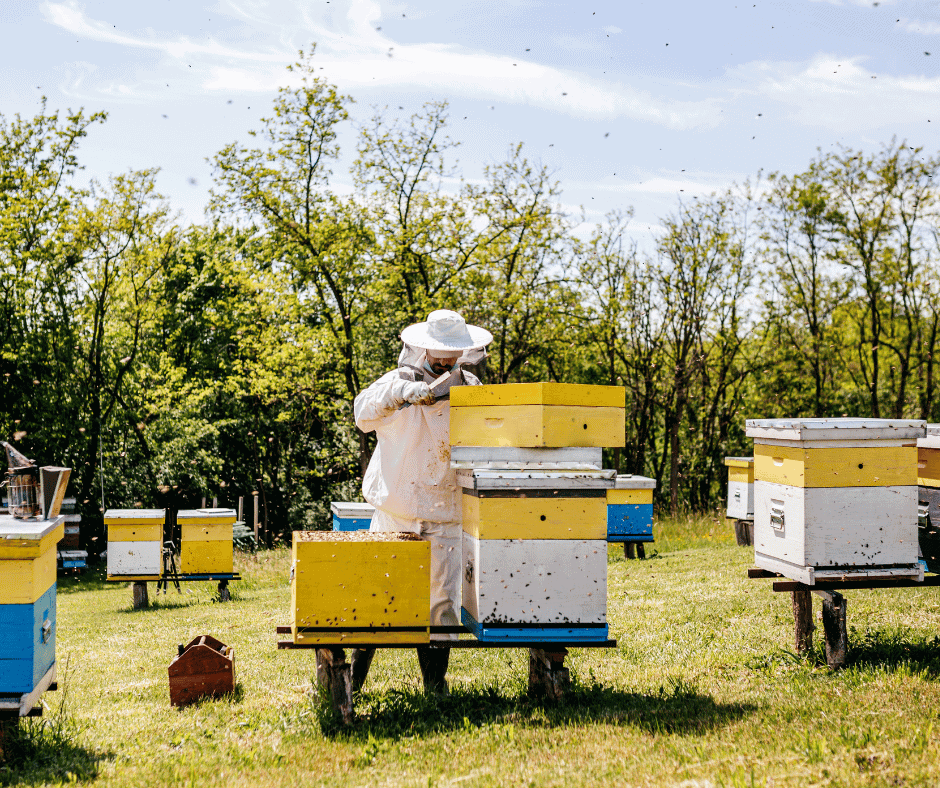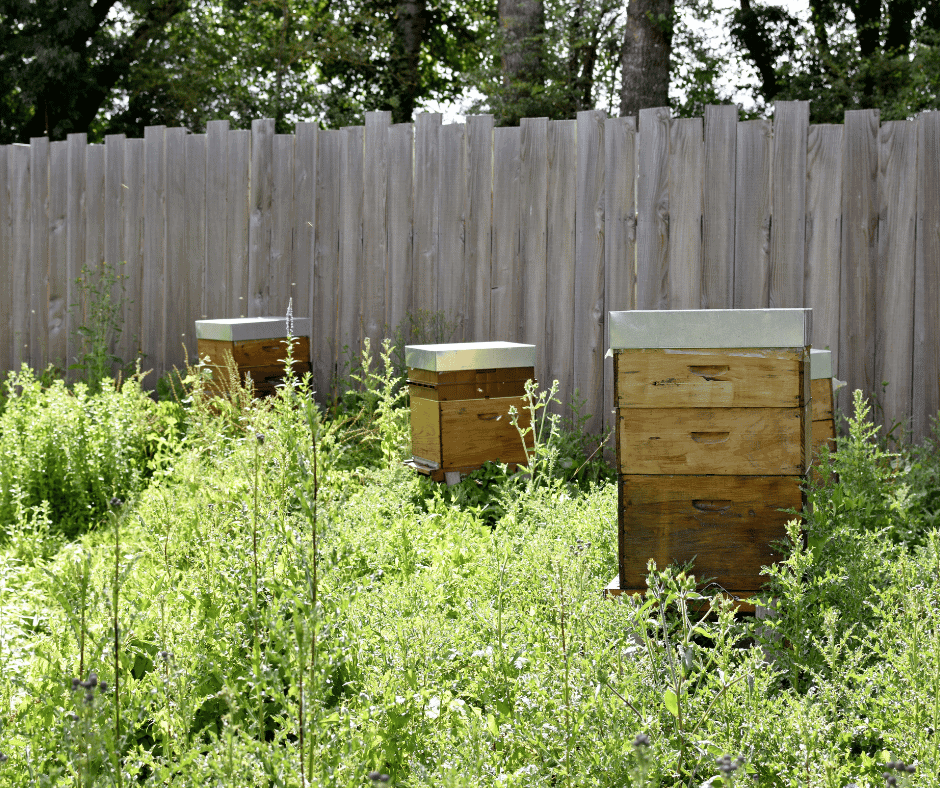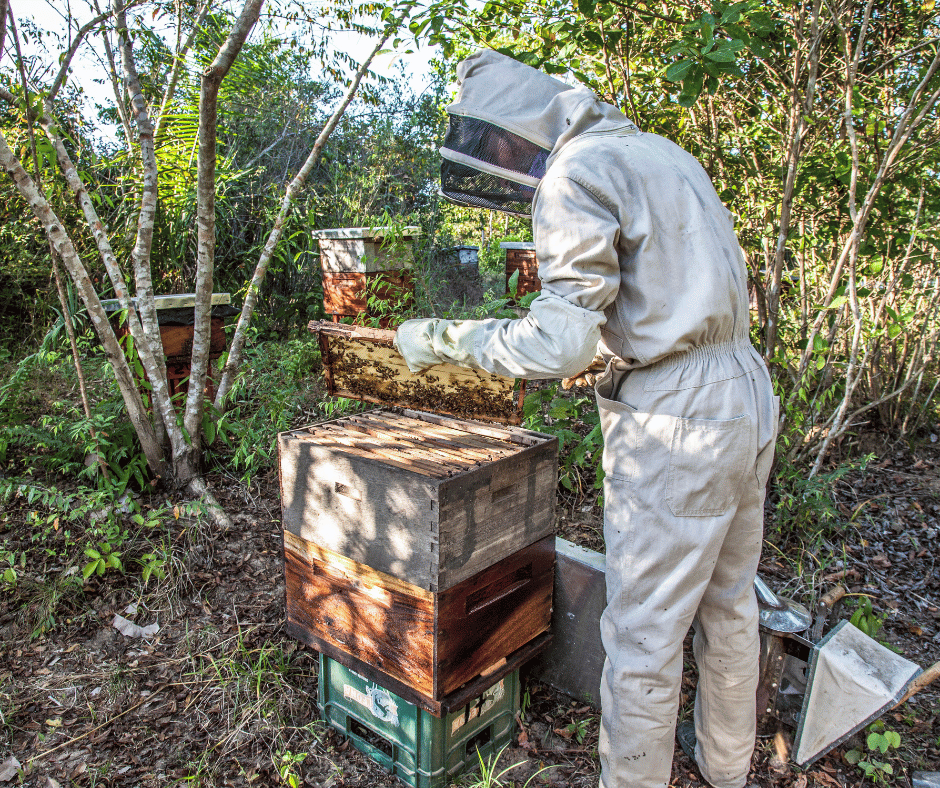
Are you looking for the perfect beehive to start your own colony of honeybees? If so, look no further! In this article, we explore which type of beehive is best-suited to fit your needs. In order to select the right type of beehive, there are several factors that need to be taken into consideration. These include size, shape, material used, and even cost – not only financially but also time and energy spent in maintaining them over time.
By understanding these variables and weighing each option carefully against its pros and cons – you can finally narrow down your choices and choose a hive that fits both your lifestyle and budget perfectly.
Table of Contents
Overview Of Beehives
Whether you’re a hobbyist or professional, there are many types of beehives to choose from. The most popular type of hive is the Langstroth Hive, which has been around since the mid-1800s. It’s designed with removable frames that can easily be accessed for inspection and honey production without disturbing the bees. Other designs include skep hives, top bar hives, Warre hives, and more. Each design offers unique benefits depending on your needs as a beekeeper.
When considering what kind of beehive to buy, it’s important to understand the differences between them all in order to make an informed decision. Different factors should be taken into account when it comes to selecting a suitable bee hive for your apiary. With this knowledge in hand, we can now explore some key considerations when deciding on the best bee hive for your needs.
Factors To Consider When Choosing A Beehive
Choosing the right beehive is like searching for a new home. You want your bees to feel safe and secure, so you need to find one that meets their needs and provides them with all the comfort they deserve.
There are various types of beehives available, each offering unique features and benefits when it comes to design and construction. Before deciding on which type of beehive you should choose, there are certain factors you must consider.
The Langstroth Beehive is one of the most popular designs among beekeepers due to its simplistic yet efficient nature. This hive consists of different boxes or “supers” stacked atop one another in order to provide space for brood rearing as well as honey storage. The advantage of this system is that it allows for easy management since each box can be manipulated independently from others within the stack.
Additionally, because of its modular nature, additional components such as frames can easily be added onto existing ones without having to start from scratch.
Furthermore, some hives offer enhanced insulation capabilities which help maintain consistent temperatures year round regardless of external environmental conditions.
No matter what kind of hive you choose, make sure it’s made out of durable materials that won’t rot over time due to water damage or exposure to other elements like wind or extreme heat/cold weather patterns. It’s also essential that any beekeeper ensure proper ventilation throughout their hives in order to prevent swarming behavior – a common problem amongst many beetle populations worldwide.
With these considerations taken into account, beginning beekeepers should have no trouble finding exactly what they’re looking for in terms of quality beehive design and construction materials that best suit their own needs and budget constraints.
From here we can explore the various types of hives and their components in more depth..
Types Of Hives And Their Components
Different types of hives have different components and can serve various purposes. It’s important to understand the differences between these beehive designs in order to decide which is best for you.
The two most common types of beehives are Langstroth and top-bar hives.
The Langstroth hive is the standard type used by beekeepers around the world and consists of multiple removable frames that fit inside boxes called supers. Top-bar hives also feature removable frames, but instead of stacking them vertically like with a Langstroth hive, they rest horizontally on top bars connected across the width of a single box structure. Each style has its own advantages and disadvantages depending on your beekeeping goals.
Parts of both types of beehives include an entrance reducer or mouse guard, inner cover, outer cover, bottom board, comb holder strips, follower boards, and foundation wax sheets (optional).
The entrance reducer helps protect bees from predators while allowing air flow into the hive body, inner covers provide insulation against extreme temperatures while the outer covers shield hives from rain.
The bottom boards help keep out pests such as skunks and other preditors, while the comb holder strips hold vertical frames in place. And finally the follower boards create additional space within a hive and wax sheets give honeybees something to build their combs off of when creating new colonies (in some cases).
No matter what type or design you choose for your bee keeping needs, understanding how each component works together will ensure success in maintaining healthy hives over time. With all this information at hand let’s take a look at different shapes and designs available today!
Different Shapes And Designs
When deciding which type of beehive to choose, it’s important to consider the different shapes and designs available.
The Langstroth Hive

The most popular bee hive is the Langstroth hive. It’s named after its creator, Rev. L.L. Langstroth, who designed the first movable frame-hive in 1851.
Its dimensions are consistent with modern hives: 10 frames wide by 14 inches deep. In addition to being easy to manage and expand, this style of hive provides plenty of room for bees to store honey and pollen while providing a safe environment for them to do so.
Another popular shape is an oblong or rectangular box that’s often used as brood chambers or supers (where they store their honey). These boxes come in many sizes depending on your needs – from shallow ones that fit 5 frames up to deeper ones that hold up to 11 frames. This makes it easier for you to customize your setup according to what works best for your colony’s size and needs.
Top Bar Hives
Another option is a top bar hive, which has been gaining popularity among beekeepers in recent years due to its simplified design and low cost compared to other types of hives. Top bar hives don’t use frames like traditional Langstroth hives; instead, they have horizontal bars along the top of the hive body where wax comb can attach itself naturally as bees build out their combs over time. T
his gives you more control over how much space each comb takes up compared with framed colonies since there isn’t any support structure around each one like there would be in a typical Langstroth hive.
Moving forward into the benefits of different materials used in constructing a hive, we’ll see that some provide better insulation than others while also offering protection against pests or extreme weather conditions…
Benefits Of Different Materials Used In Constructing A Hive
When constructing a hive, beekeepers should consider the various materials available. Wood is perhaps the most traditional and widely used material for hives, providing an attractive and sturdy structure that will last for many years with proper maintenance.
The size of the beehive depends on the type of bees you’re keeping; there are several different types of hives to choose from in order to accommodate your specific needs.
Metal hives offer a more secure alternative; these robust structures provide greater protection against pests and weather conditions while also making inspections easier due to their transparent walls.
Plastic hives are lightweight and affordable, but they don’t hold up as well over time when exposed to harsh climates or temperatures fluctuations.
Whatever type of material you decide to use, it’s important to have a clear bee hive diagram outlining all components before beginning any construction work.
No matter which material you choose, having a good-quality beekeeping hive can greatly benefit your colonies throughout the seasons – helping them thrive in even the most demanding climates!
Now, let us take a look at some pros and cons associated with langstroth hives – one of the most popular choices among modern beekeepers.
Pros And Cons Of Langstroth Hives
When deciding which type of beekeeping hives to use, Langstroth Hives are an excellent starting point. Here we will discuss the pros and cons of this popular hive style.
For starters, Langstroth Hive dimensions are designed for efficiency; they provide plenty of space for bees to store honey and build their combs in relative comfort. Additionally, these hives have been used by beekeepers for many years, so there’s a wealth of resources available when learning how to maintain them.
Furthermore, Langstroth Hives come in various sizes that can accommodate any number of colonies depending on your needs.
Also, they require more upkeep since all components must fit together perfectly in order to work correctly and prevent pest infestations.
Finally, while they’re typically made from durable materials such as wood or plastic, this also means they tend to cost more up front compared to other types of beehiving options.
Overall, if you’re looking for an efficient way to start keeping bees without too much hassle then Langstroth Hives might just be the perfect choice for you! With proper maintenance and care, this type of hive offers many advantages over its counterparts and ensures successful beekeeping endeavors year after year.
Next up: let’s explore the Pros and Cons of Top Bar Hives!
Pros And Cons Of Top Bar Hives

Top bar hives are a modern beehive option that provide several benefits over the Langstroth model. These distinctive hives consist of a simple rectangular box, with thin strips of wood laid across the top, called “bars”. The bees build their combs from these bars and hang them down into the beehive box below.
One advantage to using top bar hives is the ease of management for beekeepers. With this type of hive there is no need for heavy lifting; inspections can be done by simply removing one or two bars at a time rather than having to open up an entire side wall or lift out large frames as in other types of hives.
This makes it much easier to keep track of what is happening inside without disturbing the colony too much. Additionally, since each comb hangs separately from its neighbor, any diseased combs can easily be removed without risking damage to healthy ones nearby.
Finally, unlike Langstroth-style hives which require purchasing expensive parts like boxes and frames, all you need for a top bar hive is just one long piece of wood cut into narrow strips – making it very cost effective!
All in all, top bar hives offer an attractive alternative to traditional models – providing numerous advantages while respecting nature’s design.
Now let’s move on to explore another popular style of modern beehive – Warré Hives – let’s see how this unique design compares.
Pros And Cons Of Warre Hives

The Warre hive is one of the most popular types of beehives, and for good reason. It’s an efficient way to house bees without taking up too much space or requiring a lot of maintenance. The unique design of this type of hive makes it easy to monitor the health of your colony and quickly identify any problems before they become more serious.
As with any other beehive type, there are pros and cons associated with using a Warre hive that you should consider before making your decision.
Additionally, because these hives use a natural comb instead of foundation frames, beekeepers don’t have to worry about replacing them as often as they would with Langstroths. The cost savings alone make Warre hives worth considering when choosing the best beehive option for your needs.
Another advantage of Warre hives is their simplicity; no complex tools or heavy lifting is required! This means that anyone from novice beekeepers to experienced ones can easily manage a healthy colony within this type of setup with minimal effort.
Plus, since all components are stacked on top of each other rather than side by side like in standard Langstroth setups, it takes up less room which can help reduce costs even further if space is limited.
Overall, Warre hives offer many advantages for those looking for an economical yet effective way to keep bees happy and healthy at home. With its low cost and simple construction, it’s easy to see why so many people choose this style when selecting the best beehive option available today.
Before diving into any particular type though, it’s important to weigh both sides carefully – exploring not just what works well but also potential drawbacks – in order to make an informed decision moving forward. Let us now take a look at Flow Hives.
Pros And Cons Of Flow Hives

Flow Hives offer a unique solution to traditional beehive design. The primary benefit is that it allows for honey extraction without disturbing the bees, using a specially designed spigot system.
This means no more opening up hives and interrupting their natural environment – which can lead to fewer stings and less stress on the colony. Plus, Flow Hives come with detailed diagrams that make set-up quick and easy.
On the other hand, those who prefer more control over hive management may find this type of beehive limiting in terms of customization options.
That said, Flow Hive technology empowers hobbyists to enjoy harvesting freshly produced honey while minimizing disruption to the hive’s natural rhythms – something all beekeepers strive for! Moving forward we’ll explore other types of beehives available today…
Other Types Of Beehives
Are you looking for the perfect beehive to suit your needs? With so many options out there, it can be difficult to decide which one is right for you. Here’s a look at some of the most popular choices:
- Modern Beehives – These are typically made from plastic or wood and come in various sizes and types. From horizontal top bar hives to Langstroth boxes, these modern designs offer flexibility and ease of use. They also have an easy-to-clean design that helps keep pests away.
- BeeHive Super – This type of hive has two levels with space for both brood and honey storage. It’s great for those who want more room for their bees without having to buy additional equipment or expand the existing setup. Plus, they are relatively inexpensive compared to other models on the market.
- A Bee House – This name may sound funny but this type of hive is actually very effective when used correctly! It has compartments designed specifically for beekeeping that help protect against intruders while allowing plenty of ventilation and access points for harvesting honeycomb and pollen.
No matter what kind of beehive you choose, safety should always come first! Make sure to research the best practices before getting started so that your bees stay healthy and happy throughout their lives in your backyard or garden habitat. With just a few simple steps, you’ll soon have your own thriving hive buzzing with activity!
Video on Beginner beehive kits. What’s out there and how do they compare?
Assembling The Hive Components
Assembling a honey bee hive is an important step in achieving the best results for your bees. It’s critical to ensure that you have all of the necessary components, including the bee hives, boxes, and frames.
The first step is to assemble the hive box by connecting it with screws or nails. Once connected, place the bottom board onto the base of the box and affix cover boards over top. Next, insert frames into either side of the box and secure them with two nails or screws each.
Now it’s time to add some accessories! Place an entrance reducer at one end of the box so that only certain-sized insects can enter. Put atop a windbreak such as mesh cloth to protect against high winds. Lastly, install insulating materials like foam strips around the sides of the box for additional protection from weather-related issues.

These additions will give honey bee hives added stability and strength when exposed to harsh conditions outdoors. Your bees will be safer and better able to thrive in their new home thanks to these thoughtful precautions taken during the assembly stage.
With this knowledge in hand, let’s move on now to discuss the benefits of hive additions further.
Benefits Of Hive Additions
Many beekeepers are unsure about making changes to an old beehive, feeling that it may disrupt the honey bees. But in truth, additions to a hive can greatly benefit both the keeper and the colony.
Home bee hives can be modified for special purposes such as raising queens or controlling swarming behavior. Hive boxes of different sizes can also be added for storing nectar and honey produced by bees.
In addition to adding space, hive additions provide many other advantages. They offer greater protection from predators and keep excess moisture away from vital components like frames and combs.
Different types of insulation materials can also help regulate the temperature within the hive during extreme weather conditions. Furthermore, if something goes wrong with one box, you won’t need to replace the entire hive.
Hive additions not only ensure better management of your apiary but also make life easier for your beloved honey bees!
So don’t shy away from modifying your hives – they will thank you later! In the next section, we will look at placement considerations, how we position our hive is just as important as what kind of features we add on to it!
Placement Considerations For The Hive
Now that you have a better understanding of the benefits of adding hive additions, let’s move on to placement considerations for the hive. Choosing the right type of beehive is essential for providing your bees with a safe and comfortable home. Depending on where you live, there are different types of bee hives available.
The most common type of beehive is the National Hive, which consists of two main parts: a brood box and one or more supers (or boxes). The brood box houses all the developing bees while the supers house adult honeybees and store excess honey.

This type of beehive is easy to manage since it comes with removable frames for inspecting each box separately. It also requires minimal maintenance as its design allows for proper ventilation and insulation.
Another popular option is the WBC Hive, which features an insulated upper section known as a crown board that acts as an additional layer between your bees and outside weather conditions.

Additionally, this type of beehive usually has four separate compartments allowing you to inspect each part easily without having to open up multiple boxes at once.
While this type may require slightly more frequent inspections due to its size and complexity, it often offers superior protection against cold temperatures.
When selecting a spot for your beehive, make sure it’s away from any potential hazards like busy roads or high-traffic areas; a secluded area surrounded by trees and plants will provide plenty of natural food sources for your bees while keeping them safe from predators too.
Ensuring adequate sun exposure throughout the day is also key so that your colony can stay active even during cooler months when food resources might not be readily available nearby. With these factors taken into consideration, you’ll soon find yourself well on your way toward setting up a successful beekeeping operation!
Next, we’ll discuss some essential supplies needed for getting started with beekeeping – such as hive boxes, frames, protective gear, and other beekeeping tools.
Essential Supplies For Setting Up A Beehive
Setting up a beehive is an exciting step in becoming a beekeeper. It’s important to have all the necessary supplies on hand before starting your hive, so let’s take a look at what you need.
A good quality beehive is the most important item, it’s where your colony will live and produce their delicious honey. The frames provide support for the wax foundation which helps guide the bees as they construct their perfect hexagonal cells.
Finally, there are specialized tools such as smokers, feeders, and other accessories that can help make caring for your new friends easier. Altogether, these items will set you back around $500-$800 depending on the model you choose.
It may also be helpful to remember that if you plan on having more than one beehive, then it’s known as an apiary or ‘bee yard’ – but don’t worry if this isn’t something you’re considering right away!
Once everything has been purchased and set up correctly, you’ll soon find yourself immersed in the magical world of beekeeping with plenty of rewards along the way.
Now that we’ve covered all the essential supplies needed to get started with your own little slice of paradise – it’s time to start looking into how best to care for your bees!
How To Care For Your Bees
Once you have chosen the right type of beehive, it’s time to start caring for your bees. In order to ensure their safety and health, you will need to provide them with a clean environment, proper nutrition, and protection from pests.
The first step in beekeeping is making sure that the living space is properly maintained. This means regularly cleaning out any debris or dead bees from the hive, as well as checking for mites or other insects that can harm your colony.
You should also check for cracks or holes in the hive structure, which could allow predators access to your bees. If necessary, use wood putty or caulk to seal up any gaps.
It is also important to provide adequate nutrition for your bees throughout the year by supplying them with high-quality honeybee feed such as pollen patties or sugar syrup. Feeders are available at most garden stores and online retailers and come in many different sizes and shapes depending on what kind of beehive setup you have.
Additionally, make sure there is plenty of fresh water nearby so they can drink when needed.
Finally, keep an eye out for diseases like Nosema apis or American Foulbrood (AFB). These illnesses can spread quickly among hives so if you notice symptoms in one colony, act fast by quarantining the affected area and consulting a professional beekeeper about treatment options. With regular maintenance and monitoring, you can keep your new colony healthy and thriving!
Conclusion
Beekeeping can be an incredibly rewarding experience. Whether you’re just getting started or have been keeping bees for years, the right hive is essential to the success of your colony and its occupants.
By considering factors such as shape, size, material type, and placement when selecting a beehive, you’ll ensure that your bees are healthy and happy. With proper care and maintenance on our part, we can create safe havens for our buzzing friends who serve us – and nature – so well.
With careful planning, you can help bees thrive in their environment; allowing us all to reap the rewards of their hard work. What’s more, by providing a home for pollinators like honeybees through thoughtful design choices, I believe we can make this world a better place one buzz at a time!



